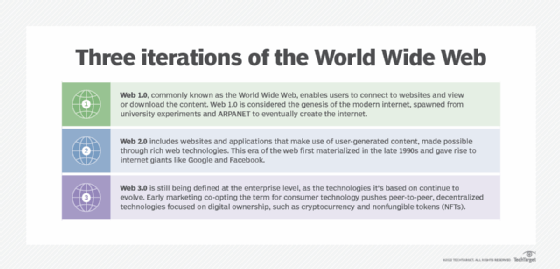Web 3.0 business opportunities, ideas and what to expect
Web 3.0 is emerging as the next evolution of the internet. Here's how it could impact business models and provide new opportunities from greater transparency and efficiency.
As Web 3.0 makes gains and technologies such as blockchain mature, the internet will change, and business will have to evolve with it. Web 3.0, also known as Web3, offers the promise of better security and brings transparency and accountability to the forefront.
With the transition from a static Web 1.0 to the interactive and dynamic Web 2.0, businesses have been able to grow and innovate with access to a global market. However, to understand where the internet is going with Web 3.0, it's important to see how it got where it is today.
What is Web 3.0 and how does it work?
Tim Berners-Lee set up the first web server in 1990 and created the World Wide Web. Back then, the internet community was limited to government and military researchers and college students.
Web 1.0 is the term used to describe the earliest versions of websites. The Domain Name System (DNS) didn't exist yet and users visited websites by typing in their IP address. For example, instead of typing in techtarget.com in the URL bar, you had to enter 206.19.49.102.
This article is part of
What is Web 3.0 (Web3)? Definition, guide and history
Web 1.0 was characterized by simple HTML designs for displaying text and images. Websites were simple displays of text, static images and links. Users couldn't edit the data, and it wasn't interactive. The early days of the web were a time when users were only consuming content, not generating it. Pages had to be as small and lightweight as possible because it was the era of dial-up connections, and websites could take minutes to load. Because Web 1.0 was before smartphones, it was only accessed by desktop computers.
The Web 2.0 era began around the start of the 21st century. The hallmark of Web 2.0 is interactivity. Pages were no longer static but dynamically generated for the user. The pages were bigger and more complex as broadband expanded its reach. Streaming music and video became increasingly common.
With Web 2.0 came the advent of user-generated content. It started with precursors to social media, such as GeoCities, before social media sites like Myspace, Facebook, Twitter and Instagram took off. Web 2.0 allowed considerably more user input and engagement through blogs, tweets and social networks.
The definition of Web 3.0 is slowly coming into focus. For starters, Web 3.0 aims to be fully decentralized, putting content creation in the hands of the creators and not platform owners. In many ways, this is what Berners-Lee originally envisioned when he created the web. Web 3.0 consists of the following five notable features:
- Semantic Web. The Semantic Web uses AI to understand what a user or customer means or intends, thus improving the accuracy of the information conveyed and enhancing the overall experience. It's designed to improve web technologies to generate, share and connect content through more accurate understanding of searches based on the meaning of words, rather than on keywords or numbers.
- Artificial intelligence. It's not unusual for users to search for a keyword and receive unrelated results. The AI of Web 3.0 is designed to better understand what users are searching for and give more relevant answers.
- 3D graphics and spatial web. There were attempts to make a 3D representation of the web and websites dating back to the 1990s. However, the graphics were primitive, slow and failed to catch hold. With advances such as virtual reality, 3D graphics provide a more realistic online experience. Some industries have already incorporated 3D graphics in their promotion of products and services, such as special events and branding.
- Blockchain and cryptocurrency. Blockchain and cryptocurrency technology are foundational to Web 3.0. The hallmark of Web 3.0 is decentralization and giving greater control to content creators. Blockchain and cryptocurrency are designed to eliminate intermediaries and allow for direct transactions between parties. Blockchain helps make Web 3.0 more transparent and secure while cryptocurrency eliminates intermediaries, such as financial institutions, which proponents consider beneficial.
- Ubiquitous connectivity. Web 3.0 applications are characterized by ubiquitous connectivity thanks to broadband, 5G and IoT, which provide access to information from a variety of devices, such as smartphones and tablets, not just PCs.

Business opportunities and benefits of Web 3.0
If it comes to pass, Web 3.0's impact on business could be more transparency and a greater orientation to users and customers than with today's web. Therefore, the way businesses employ users' data will change. Because blockchain technology is at the core of Web 3.0, current web apps will require a blockchain upgrade if they want to play in Web 3.0.
Some of the benefits of Web 3.0 for businesses include the following:
- No third party required. Blockchain, smart contracts and decentralized applications eliminate third-party service providers. For example, cryptocurrency reduces the need for banks, and all financial transactions are only between the two parties. Web 3.0 advocates say this will help businesses reduce costs and be more competitive.
- Improved regulatory compliance. Blockchain is an unchangeable record of transactions visible to everyone on the chain, its proponents claim. Thus, it could make it easy for companies to comply with their governance requirements by maintaining transparency.
- Greater accountability. Thanks to blockchain, every transaction can, in theory, be tracked to make companies accountable for their actions. This could make it easier for people to buy products from businesses with a good reputation.
- Improved security. Web 3.0 should make it harder for hackers to access sensitive information. Because of blockchain's decentralized and distributed nature, there is no single point of failure, which makes it more difficult to corrupt. Blockchain data usually can't be altered or manipulated, so businesses will be able to worry less about data theft and breaches.
- Improved customer relations. With Web 3.0, every transaction is recorded in the decentralized blockchain ledger for all parties involved to see, making companies directly accountable to their customers. Businesses can use this transparency to build trust and long-lasting relationships with their customers. Because data stored on blockchain is designed to be unchangeable, customers know that the information is authentic and hasn't been modified.
- Supply chain management. Businesses could more easily monitor and track their supply chains on Web 3.0 thanks to blockchain's transparency. By eliminating silos, businesses can quickly identify problems in manufacturing and delivery services, improving time management and reducing cost. Businesses can also share crucial information, such as production schedules and contract deadlines, with their suppliers, which could help to make delivery smoother.
What does Web 3.0 mean for business?
Web 3.0 technologies can help to improve transparency and trust between businesses and their customers by creating a tamper-proof record of transactions on a blockchain. With a real-time view of the supply chain, customers can see where their products are at each stage of the production process.
It also means fewer go-betweens. By utilizing blockchain networks, there is no need to rely on a single centralized institution as a source, such as a bank. Businesses can also confirm that transactions are cryptographically protected and verified. If its advocates are right, the distributed nature of Web 3.0 means it will be both safer and cheaper. Thanks to decentralization, user data won't be stored in one place, making it less vulnerable to attack or loss. Because Web 3.0 is meant to be decentralized, Web 3.0 apps probably won't require expensive servers and data centers. Instead, they can run on a network of computers provided by end users.
Data ownership moves from Web 2.0 style, which involves large, centralized entities that provide services and access to their platforms in exchange for monetizing users' personal data, to Web 3.0, which involves decentralized applications without data monetization.
Data will be shared among multiple apps and services rather than owned by entities such as social networks. This means people will have ownership and control over their personal data, which has become a point of contention. The new ownership model could inhibit the use of bots and fraudulent accounts, as well as trolling and spamming. In turn, this will help lock out scammers and other disreputable online sellers.
Web 3.0 uses cryptocurrency, such as Bitcoin and Ethereum, to make transactions occur in real time. Transactions aren't going through banks, which may take days to process an international purchase. A cryptocurrency transaction can take place in minutes, if not seconds.
However, the recent collapse of the cryptocurrency market has thrown the entire concept into doubt as billions of dollars have been lost with the implosions of FTX, Crypto.com and Bitcoin. The cryptocurrency industry will need time to shake out poorly capitalized and fraudulent players.
Web 3.0 could also curtail fake news and fabricated new stories, which can be damaging to a company's reputation. Advocates claim that disreputable news sources will no longer have to be verified through a third-party source, which itself can also be disreputable. With certain Web 3.0 apps, users can verify a news source through its blockchain.
The decentralized nature of Web 3.0 and lack of central servers -- part of the original vision of a decentralized web -- means fewer opportunities for network downtime, which can equal critical losses of business.
Web 3.0 is still in the developmental stage, and new companies built on the technology are only now beginning to emerge. Businesses should keep an eye on its progress to capitalize on the opportunities that arise when the day comes that Web 2.0 phases out and Web 3.0 becomes the norm.







